
We stopped in the Bünich pass for an awesome view down to Lungern and the Lungerersee.
At Lauterbrunnen we parked the car and traveled by train past Wengen to Kleine Scheidegg.
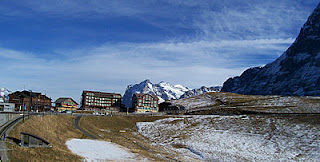
The Jungfrau region is dominated by the triple peaks of the Eiger, Mönch and Jungfrau (Ogre, Monk and Virgin). The Jungfraujoch, at 3,454 m high, is the saddle below the Jungfrau peak that claims the honour of being the site of the highest train station in Europe, and is dubbed the “Top of Europe”.

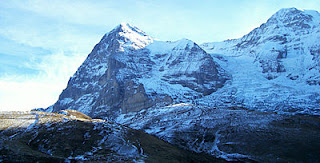
The Jungfrau peak is 4,158 m high, and was first ascended by the Meyer brothers in 1811. The Aletsch Glacier is on the south side. The Jungfraujoch has a scientific institute with a meteorological station on the nearby Sphinx summit, 3,573 m high.

From Kleine Scheidegg the Jungfraubahn cog train took us right up and inside the top of the mountain at Jungfraujoch. The train enters the tunnel running eastward through the Eiger shortly after leaving Kleine Scheidegg. It runs close behind the Eiger's north face, stopping at Eigerwand, where there is a window about 8 m long and a metre high halfway up the face.
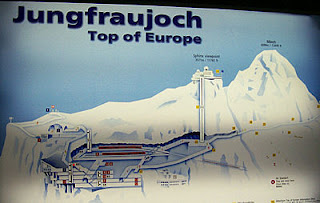
The windows have been placed in holes used to remove excavated rock from the tunnel during construction, and are also occasionally used as access points to rescue climbers. There one can get off the train to admire the view before the train continues five minutes later. The tunnel then turns west, heading towards the Jungfrau. There is a second stop at a window looking out on the Eismeer (Sea of Ice) before the train continues to the Jungfraujoch.
The tunnel was constructed between 1898 and 1912 and is about 7 km long, with gradients of up to 25%. The journey from Kleine Scheidegg to Jungfraujoch takes approximately 50 minutes including the stops at Eigerwand and Eismeer while the downhill return journey taking only 35 minutes.
A large complex of tunnels and buildings has been constructed at the Jungfraujoch, mostly into the south side of the Mönch.
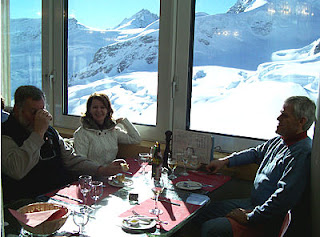
There is a hotel, two restaurants, an observatory, a research station, a small cinema, a ski school, and the Ice Palace (Eispalast), a collection of elaborate ice sculptures in tunnels made into the ice of the glacier. Another tunnel leads outside to a flat, snow-covered area, where one can walk around and look down to the Konkordiaplatz, the Aletsch Glacier and the surrounding mountains.

We had lunch at the Crystal Restaurant before taking a walk outside on the plateau and visiting the Ice Palace and the Sphinx. We spent a leisurely hour in the restaurant, having a yummy lunch and basking in the bright sunshine, enjoying the view of mountain peaks and the glacier.

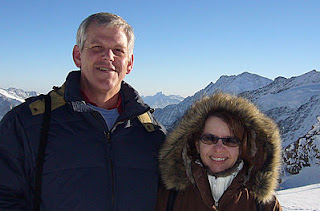
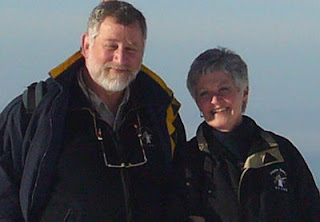
Here are some pictures of us on the plateau outside. We had to walk carefully on the packed snow as it was quite slippery on the sloping parts. Pierre managed to get a lovely picture of us standing under the Swiss flag, timing it just right for the flag to fly out in the light breeze.
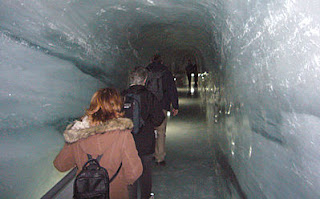
Then two more pictures of us outside in the bright sunshine: first Pierre and Ronel, then Willem and Leta.
The Ice Palace is a maze of tunnels carved into the ice layer covering the mountain, with small caves as display areas for some rather amazing ice sculptures.
One enters the Ice Palace and at first it is quite scary to be walking on the ice floor, but soon it is clear that one does not slip all that easily, and we became more confident in striding about.

We did the typical tourist thing, taking our pictures at all the obvious opportunities, like this one - Leta and Ronel looking rather silly, but it was fun!

Enjoy our pictures of two of the ice sculpture displays - first the igloo with Eskimo and seals, and then the eagles. One eagle is shown having caught himself a nice fat fish.
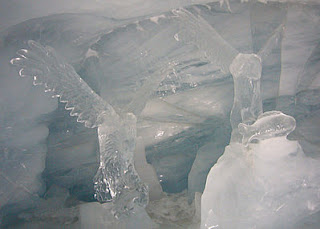

Still in the Ice Palace, enjoy the picture of Willem and Ronel peering from a window in an ice cave. Maybe this was supposed to be a bar, but they did not serve us any drinks!

The highest point we reached was at the Shpinx lookout platform 3571 m above sea level. We found the thin air tough to handle, feeling weak and dizzy, heart racing, after climbing a few stairs to the viewing platform.
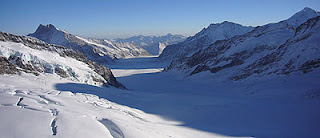
Pierre took a lovely picture of the glacier from the high vantage point, the Sphinx viewing platform.
On the return journey down the mountain late that afternoon the moon was already up as dusk was falling.
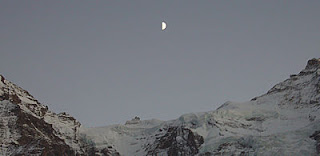
This last picture shows the moon hanging above the Shinx. We returned home that evening well satisfied with the amazing experiences of the day.
The sight of the majestic mountains and vast snowscapes will not be forgotten.

No comments:
Post a Comment